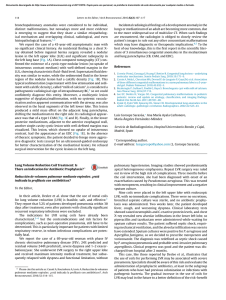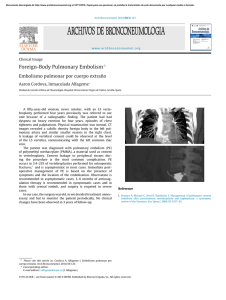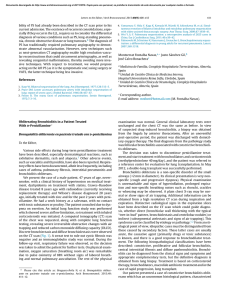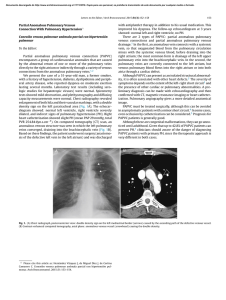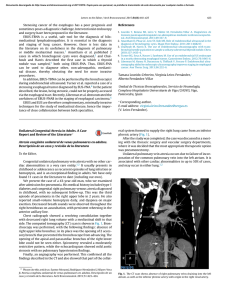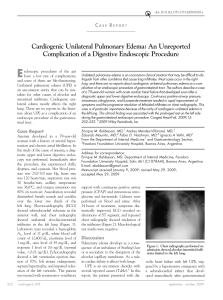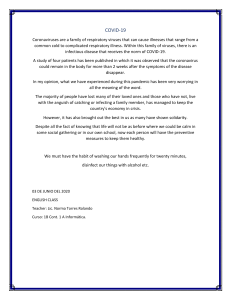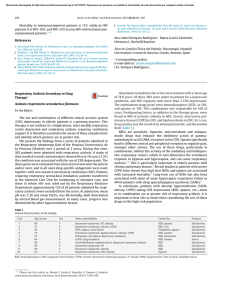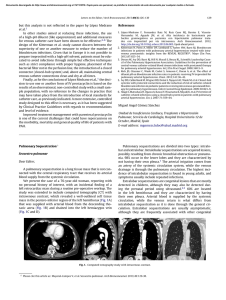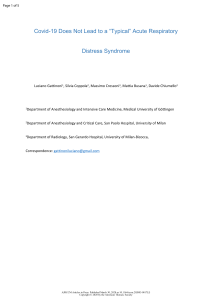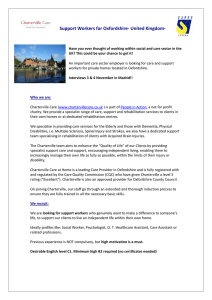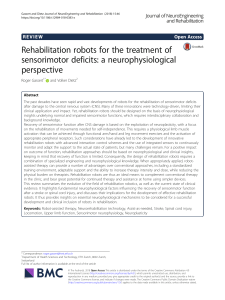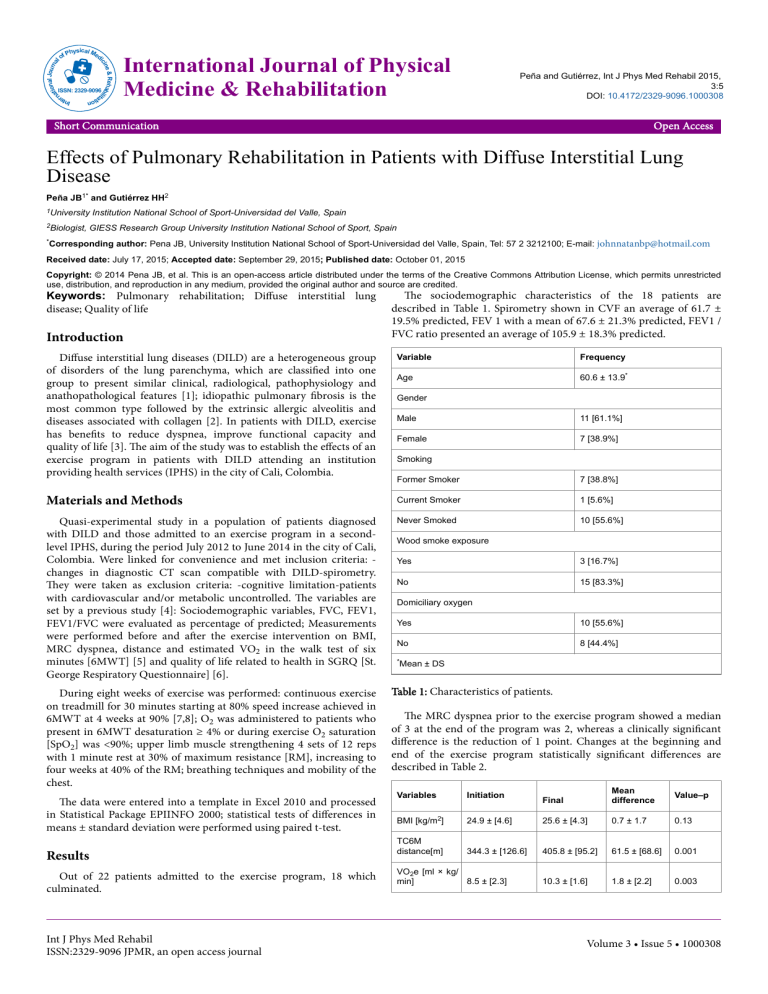
al Journ tion al na & Rehab ne ilit ici sic Phy al Med of ISSN: 2329-9096 International Journal of Physical Medicine & Rehabilitation Peña and Gutiérrez, Int J Phys Med Rehabil 2015, 3:5 DOI: 10.4172/2329-9096.1000308 Open Access on ati Inte r Short Communication Effects of Pulmonary Rehabilitation in Patients with Diffuse Interstitial Lung Disease Peña JB1* and Gutiérrez HH2 1University 2Biologist, Institution National School of Sport-Universidad del Valle, Spain GIESS Research Group University Institution National School of Sport, Spain *Corresponding author: Pena JB, University Institution National School of Sport-Universidad del Valle, Spain, Tel: 57 2 3212100; E-mail: johnnatanbp@hotmail.com Received date: July 17, 2015; Accepted date: September 29, 2015; Published date: October 01, 2015 Copyright: © 2014 Pena JB, et al. This is an open-access article distributed under the terms of the Creative Commons Attribution License, which permits unrestricted use, distribution, and reproduction in any medium, provided the original author and source are credited. Keywords: Pulmonary rehabilitation; Diffuse interstitial lung disease; Quality of life Introduction Diffuse interstitial lung diseases (DILD) are a heterogeneous group of disorders of the lung parenchyma, which are classified into one group to present similar clinical, radiological, pathophysiology and anathopathological features [1]; idiopathic pulmonary fibrosis is the most common type followed by the extrinsic allergic alveolitis and diseases associated with collagen [2]. In patients with DILD, exercise has benefits to reduce dyspnea, improve functional capacity and quality of life [3]. The aim of the study was to establish the effects of an exercise program in patients with DILD attending an institution providing health services (IPHS) in the city of Cali, Colombia. The sociodemographic characteristics of the 18 patients are described in Table 1. Spirometry shown in CVF an average of 61.7 ± 19.5% predicted, FEV 1 with a mean of 67.6 ± 21.3% predicted, FEV1 / FVC ratio presented an average of 105.9 ± 18.3% predicted. Variable Frequency Age 60.6 ± 13.9* Gender Male 11 [61.1%] Female 7 [38.9%] Smoking Former Smoker 7 [38.8%] Materials and Methods Current Smoker 1 [5.6%] Quasi-experimental study in a population of patients diagnosed with DILD and those admitted to an exercise program in a secondlevel IPHS, during the period July 2012 to June 2014 in the city of Cali, Colombia. Were linked for convenience and met inclusion criteria: changes in diagnostic CT scan compatible with DILD-spirometry. They were taken as exclusion criteria: -cognitive limitation-patients with cardiovascular and/or metabolic uncontrolled. The variables are set by a previous study [4]: Sociodemographic variables, FVC, FEV1, FEV1/FVC were evaluated as percentage of predicted; Measurements were performed before and after the exercise intervention on BMI, MRC dyspnea, distance and estimated VO2 in the walk test of six minutes [6MWT] [5] and quality of life related to health in SGRQ [St. George Respiratory Questionnaire] [6]. Never Smoked 10 [55.6%] During eight weeks of exercise was performed: continuous exercise on treadmill for 30 minutes starting at 80% speed increase achieved in 6MWT at 4 weeks at 90% [7,8]; O2 was administered to patients who present in 6MWT desaturation ≥ 4% or during exercise O2 saturation [SpO2] was <90%; upper limb muscle strengthening 4 sets of 12 reps with 1 minute rest at 30% of maximum resistance [RM], increasing to four weeks at 40% of the RM; breathing techniques and mobility of the chest. The data were entered into a template in Excel 2010 and processed in Statistical Package EPIINFO 2000; statistical tests of differences in means ± standard deviation were performed using paired t-test. Results Out of 22 patients admitted to the exercise program, 18 which culminated. Int J Phys Med Rehabil ISSN:2329-9096 JPMR, an open access journal Wood smoke exposure Yes 3 [16.7%] No 15 [83.3%] Domiciliary oxygen Yes 10 [55.6%] No 8 [44.4%] *Mean ± DS Table 1: Characteristics of patients. The MRC dyspnea prior to the exercise program showed a median of 3 at the end of the program was 2, whereas a clinically significant difference is the reduction of 1 point. Changes at the beginning and end of the exercise program statistically significant differences are described in Table 2. Final Mean difference Value–p 24.9 ± [4.6] 25.6 ± [4.3] 0.7 ± 1.7 0.13 344.3 ± [126.6] 405.8 ± [95.2] 61.5 ± [68.6] 0.001 10.3 ± [1.6] 1.8 ± [2.2] 0.003 Variables Initiation BMI [kg/m2] TC6M distance[m] VO2e [ml × kg/ min] 8.5 ± [2.3] Volume 3 • Issue 5 • 1000308 Citation: Peña JB, Gutiérrez HH (2015) Effects of Pulmonary Rehabilitation in Patients with Diffuse Interstitial Lung Disease. Int J Phys Med Rehabil 3: 308. doi:10.4172/2329-9096.1000308 Page 2 of 2 2. SGRQ Symptoms 43.6 ± [16.5] 30 ± [11.5] 13.6 ± [19.3] 0.008 Activity 61.2 ± [16.2] 46 ± [26.3] 15.2 ± [31.6] 0.06 Impact 37.7 ± [17.7] 25.9 ± [12.6] 11.8 ± [20.2] 0.02 Total 47.4 ± [15.7] 33.2 ± [14.2] 14.2 ± [19.9] 0.008 *Values 3. 4. mean ± DS 5. Table 2: Changes after intervention. 6. Conclusion Previous studies established that patients with DILD to obtain a minimal difference in the walk test six minutes at the end of pulmonary rehabilitation program in the range of 24-34 meters [9], but was identified that women walked less distance compared with men. Despite the small number of patients involved in the study, there was a significant increase in the distance covered in the walk test of six minutes [10]. The questionnaire St. Georges proved to be an effective tool to assess quality of life related to health for both men and women [11], finding a statistically significant improvement in average total symptom domains, impact and these changes appear as an exercise program generates benefits in quality of life related to health in patients with DILD regardless of gender to which they belong. Symptomatic patients with DILD, with impaired functional capacity and quality of life benefit from an exercise program for 8 weeks, so it is safe and is recommended as an alternative treatment for all symptomatic patients with DILD [12]. References 1. Bradley B, Branley H, Egan J, Greaves M, Hansell D, et al. (2008) Interstitial lung disease guideline: the British Thoracic Society in collaboration with the Thoracic Society of Australia and New Zealand and the Irish Thoracic Society. Thorax 63: 1-58. Int J Phys Med Rehabil ISSN:2329-9096 JPMR, an open access journal 7. 8. 9. 10. 11. 12. Raghu G, Collard HR, Egan JJ, Martinez FJ, Behr J, et al. (2011) An official ATS/ERS/JRS/ALAT statement: idiopathic pulmonary fibrosis: evidence-based guidelines for diagnosis and management. Am J Respir Crit Care Med 183: 788-824. Kaymaz D, Ergün P, Candemir I, Utku E, Demir N, et al. (2013) Pulmonary rehabilitation in interstitial lung diseases. Tüberküloz ve toraks 61: 295-302. Peña JB (2014) Características de ingreso de pacientes con enfermedad pulmonar intersticial difusa en un programa de rehabilitación pulmonar. Revista Movimiento Científico 8: 61-70. ATS statement: guidelines for the six-minute walk test (2002). American Journal of Respiratory and Critical Care Medicine 166: 111-117. Vigil L, Güell MR, Morante F, López De Santamaría E, Sperati F, et al. (2011) The validity and sensitivity to change of the Spanish selfadministered version of the Chronic Respiratory Questionnaire [CRQSAS]. Archivos de Bronconeumología 47: 343-349. Holland AE, Hill CJ, Glaspole I, Goh N, McDonald CF (2012) Predictors of benefit following pulmonary rehabilitation for interstitial lung disease. Respiratory medicine 106: 429-35. Nishiyama O, Kondoh Y, Kimura T, Kato K, Kataoka K, et al. (2008) Effects of pulmonary rehabilitation in patients with idiopathic pulmonary fibrosis. Respirology 13: 394-399. Holland AE, Hill CJ, Conron M, Munro P, McDonald CF (2009) Small changes in six-minute walk distance are important in diffuse parenchymal lung disease. Respiratory medicine 103: 1430-1435. Lederer DJ, Arcasoy SM, Wilt JS, D'Ovidio F, Sonett JR, et al. (2006) Sixminute-walk distance predicts waiting list survival in idiopathic pulmonary fibrosis. American journal of respiratory and critical care medicine 174: 659-664. Jastrzebski D, Gumola A, Gawlik R, Kozielski J (2006) Dyspnea and quality of life in patients with pulmonary fibrosis after six weeks of respiratory rehabilitation. Journal of physiology and pharmacology 57:139-148. Holland AE, Hill CJ, Conron M, Munro P, McDonald CF (2008) Short term improvement in exercise capacity and symptoms following exercise training in interstitial lung disease. Thorax 63: 549-554. Volume 3 • Issue 5 • 1000308
